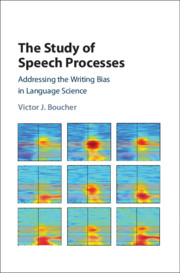Book contents
- The Study of Speech Processes
- The Study of Speech Processes
- Copyright page
- Contents
- Figures
- Tables
- Abbreviations
- Preface
- Introducing a Fundamental Problem of Language Science
- Part I Questions of Ontology: Writing and the Speech–Language Divide
- Part II Questions of Epistemology: The Role of Instrumental Observations
- Part III The Structure of Speech Acts
- 6 Utterances as Communicative Acts
- 7 Relating to Basic Units: Syllable-Like Cycles
- 8 Relating Neural Oscillations to Syllable Cycles and Chunks
- 9 Breath Units of Speech and Their Structural Effects
- Part IV The Processing of Speech Meaning
- References
- Index
9 - Breath Units of Speech and Their Structural Effects
from Part III - The Structure of Speech Acts
Published online by Cambridge University Press: 14 January 2021
- The Study of Speech Processes
- The Study of Speech Processes
- Copyright page
- Contents
- Figures
- Tables
- Abbreviations
- Preface
- Introducing a Fundamental Problem of Language Science
- Part I Questions of Ontology: Writing and the Speech–Language Divide
- Part II Questions of Epistemology: The Role of Instrumental Observations
- Part III The Structure of Speech Acts
- 6 Utterances as Communicative Acts
- 7 Relating to Basic Units: Syllable-Like Cycles
- 8 Relating Neural Oscillations to Syllable Cycles and Chunks
- 9 Breath Units of Speech and Their Structural Effects
- Part IV The Processing of Speech Meaning
- References
- Index
Summary
Constraints on processes of motor speech shape syllable-size cycles and chunked sequences of these cycles. Since these units involve pulses of air, they are also structured in terms of respiratory functions. Mechanisms of speech breathing are discussed with a view on how they constrain the number of syllables and morphemes within breath units of speech, or “utterances.” Results are presented showing that a standard measure of “mean length of utterance” involving morpheme counts and viewed as an index of grammatical development is influenced by the growth of respiratory volumes. This suggests that developing combinatorial assemblies within utterances link to maturational changes in motor speech.The chapter concludes on a summary of how observable structures of spoken language address a writing bias that comes from analyzing speech in terms of words and sentences on a page. Compared to these culture-specific concepts, syllable-size cycles, chunks, and utterances as breath units of speech constitute biologically based structures of spoken language and language processing.
Keywords
- Type
- Chapter
- Information
- The Study of Speech ProcessesAddressing the Writing Bias in Language Science, pp. 182 - 196Publisher: Cambridge University PressPrint publication year: 2021

